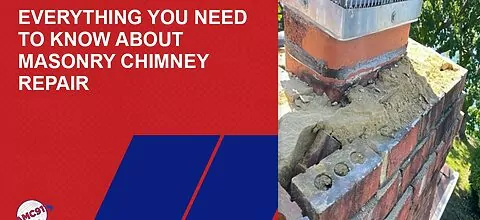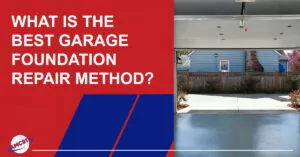Are you searching for information about masonry chimney repair? If so, don’t hit that back button because that’s what we’re going to talk about in this article. We will review the most common masonry chimney repairs, signs you might need masonry chimney repair and more.
Signs You Need Masonry Chimney Repair
The chimney is essential to any home, facilitating the safe expulsion of combustion gasses. However, like other parts of your house, it requires regular maintenance and upkeep to ensure it functions optimally. If you’ve noticed signs of wear and tear on your chimney, addressing them immediately is crucial. Some of the most common signs that indicate your chimney requires masonry repair include deteriorating mortar joints, cracked bricks, water damage, and rusted or damaged chimney caps. By tackling these issues early on, you’ll enhance your chimney’s appearance and guarantee the safety and comfort of your home for years to come.
What Are The Most Common Masonry Chimney Repairs?
Masonry chimneys have been a preferred choice for homeowners for years. However, like any other structure, they need upkeep and maintenance to remain functional and safe. The most common masonry chimney repairs include the following:
- Fixing cracks in the bricks or mortar
- Replacing damaged or missing mortar joints
- Repairing or replacing the chimney crown. (The crown, a slab of concrete or mortar located on top of the chimney, helps to prevent water from getting inside and causing damage.)
It is essential to address these problems promptly to prevent further damage and potential safety risks. Professional masonry repair contractors can conduct regular inspections and make necessary repairs to ensure the longevity of your chimney and the safety of your home.
Chimney Cracks Repair
There are various methods of chimney crack repair. More minor cracks are usually repaired using a sealant. This creates a watertight barrier and prevents further damage. This is especially useful in areas with frequent temperature changes, as the sealant can expand and contract to accommodate these fluctuations. Larger chimney cracks are often repaired using mortar.
Chimney Crown Repair
When repairing chimney crowns, the first step is to inspect the condition and identify any cracks, gaps, or holes that may be present. Once identified, the damaged areas are cleaned of debris, and any loose material is removed. The next step is to fill any gaps or cracks with a waterproof sealant formulated to adhere to the masonry.
In cases where the chimney crown damage is severe, a full replacement may be necessary. The damaged crown is removed, and a new one is constructed using durable and weather-resistant materials such as concrete, metal, or stone.
Chimney Liner Repair
Chimney liners are essential to any chimney system as they protect the masonry from the acidic byproducts of combustion and prevent dangerous gasses from leaking into the home. However, over time, chimney liners can become damaged due to age, exposure to extreme temperatures, or other factors. When this happens, it is crucial to repair the chimney liner to ensure the safety and efficiency of the chimney system.
The repair process for chimney liners depends on the extent of the damage and the type of liner. If the liner is cast-in-place or a metal liner, repair often involves removing and replacing the damaged section with a new one. Sometimes, a chimney liner can be repaired using a technique known as “slip casting,” in which a new liner is created inside the existing liner, effectively sealing any cracks or holes.
Faulty Chimney Design
A faulty chimney design can be a significant safety hazard for homeowners. Turning a peaceful night by the fire into a disaster doesn’t take much. Inadequate draft, insufficient insulation, or even the wrong materials can all contribute to a severe fire hazard. Unfortunately, many homeowners may not even realize their chimney is risking their safety. That’s why it’s so important to have regular inspections performed by a professional. Don’t take chances when it comes to your home; invest in proper chimney maintenance and keep your family safe.
Chimney Flue Repair
When it comes to the repair of chimney flues, there are several ways to do it. The most common approach is to replace or repair the damaged part of the flue. This can involve different techniques such as sealing, repointing, or relining.
Sealing involves applying a sealant to any gaps or cracks present in the flue. This is a temporary solution and should only be used in small cracks on the surface of chimney flues.
Repointing involves repairing the mortar joints between bricks in the flue. This is typically done when the mortar joints have deteriorated, or the flue shows signs of water leaks. Repointing repairs damage and improves chimney function by increasing the draft and reducing the risk of chimney fires.
Relining is another option for chimney flue repair. It involves installing a new liner within the existing flue. This is necessary when the flue is damaged beyond repair and can no longer be patched up with sealants or repointing. The new liner typically consists of stainless steel, clay, or cast-in-place concrete.
Chimney Damper Repair
Chimney dampers are an essential component that helps regulate airflow in a chimney by opening and closing the flue. Over time, these dampers can become damaged due to wear and tear, which makes them less effective in controlling airflow. The good news is that chimney dampers can be repaired rather than replaced, saving homeowners a considerable amount of money.
The first step in repairing a chimney damper is to inspect it for any visible signs of damage. Common issues may include bent or cracked flue tiles or a warped damper blade. If the damage is minor, repairing the chimney damper with a simple fix, such as tightening screws or bolts or replacing worn-out gaskets, may be possible.
Sometimes, the entire damper assembly may need to be replaced due to extensive damage or wear. A skilled chimney repair professional will carefully remove and replace the damaged damper with a new assembly, ensuring it is fitted snugly and functioning correctly.
Firebox Repointing And Rebuilding
Generally, the chimney firebox repair process involves removing the damaged firebrick and relaying new ones. Firebrick is resistant to high heat and is the preferred material used in fireboxes and fireplaces. The mortar that holds the firebrick in place can also deteriorate due to heat exposure, so it may also need to be replaced.
When repairing chimney fireboxes, professional masons or chimney specialists will typically inspect the damage and determine whether a partial or complete repair is necessary. In a partial repair, only the damaged firebrick and mortar are removed and replaced, whereas a complete rebuild involves removing and rebuilding the entire firebox from scratch. Sometimes, chimney professionals may recommend replacing the entire chimney if the damage is extensive.
Leaning Chimneys
A leaning chimney is often caused by the home’s foundation settling unevenly into the ground. If the leaning chimney collapses, it could cause extensive damage. Therefore, taking action as soon as possible is essential if you notice a chimney leaning to prevent any harm to your property. Regular chimney inspections and maintenance can help identify any potential danger and keep your home safe.
Are Chimney Cracks Serious?
Yes, chimney cracks are very serious. It’s essential to have them inspected by a professional to determine their severity. Ignoring chimney cracks can lead to serious consequences, including carbon monoxide poisoning or a house fire. So, if you notice any cracks in your chimney, it’s best to take action sooner rather than later.
How Much Does It Cost To Fix Cracked Masonry?
The answer to how much it costs to fix cracked masonry is not straightforward. The cost of the repair job depends on several factors, such as the extent of the damage, the materials required, the repair’s complexity, and the building’s location. Consult a professional chimney mason to get an accurate cost estimate. The good news is that repairing cracked masonry can help prevent more significant, costly damage from occurring in the long run and can improve the visual appeal of your property.
FAQ
What Is The Lifespan Of A Masonry Chimney?
The lifespan of a masonry chimney can vary depending on several factors, such as the type of material used, quality of construction, and maintenance. However, a well-built masonry chimney can last 50 to 100 years or more on average. It’s important to have your chimney inspected regularly by a professional to ensure it’s still structurally sound and not a safety hazard to your home and family. With proper care, your masonry chimney can last for many warm and cozy winters.
Can Crumbling Bricks Be Repaired?
Yes, crumbling bricks can be repaired, and your brick structure restored to its former glory. Whether you opt for brick replacement, repointing, or cleaning, a skilled professional can help you achieve the desired outcome. So, don’t let those crumbling bricks get you down. There’s always a solution.
What Causes Chimney Bricks To Crumble?
Chimney bricks can deteriorate for various reasons, including weathering, the type of mortar used, and even poor construction.
- Harsh weather conditions, such as rain, wind, and snow, can cause the bricks to become damaged and eventually crumble.
- The type of mortar used is also important, as certain types can be more susceptible to cracking and breaking down over time.
- Additionally, if the chimney wasn’t constructed correctly in the first place, it can lead to structural problems and, eventually, crumbling bricks.
Whatever the cause, monitoring your chimney and addressing any issues as soon as possible is important to ensure its longevity and safety.
What Causes Masonry Cracks?
One common cause of masonry cracks is water damage, which can weaken the structure and cause cracks to form over time. Other causes may include the following:
- Improper installation
- Soil movement
- Exposure to extreme weather conditions
Understanding what causes masonry cracks can help you take preventative measures to protect your home from further damage. With proper care and maintenance, masonry structures can last many years.
Do Chimneys Leak In Heavy Rain?
Chimneys can leak during heavy rain, but it depends on several factors, including the age and condition of your chimney, the construction materials, and whether it’s been properly maintained. All play a role in determining whether your chimney will hold up during a downpour.
How Do You Waterproof A Leaking Chimney?
The first step in waterproofing a leaking chimney is to identify the source of the leak. This can be tricky, but a professional can help you pinpoint the issue. Once you know where the leak is coming from, there are several methods you can use to waterproof your chimney, including applying a chimney sealant or waterproofing agent, installing a chimney cap or cover, and repairing or replacing any damaged flashing or masonry. A properly waterproofed chimney can help prevent costly water damage to your home and give you peace of mind during the next big rainstorm.
Ultimately, masonry chimney repair is an important and demanding task that should be managed by a skilled professional who understands the intricacies of the job. While all types of chimney repairs can be costly, it’s essential to address any damage quickly to avoid more significant repairs in the future. Additionally, regular inspections of your masonry chimney are vital for preventing major problems down the line.
If you think your masonry chimney in Hampton Roads might need repair, contact AMC911 today to schedule a chimney evaluation. If we find a problem, we’ll give you a repair estimate.















